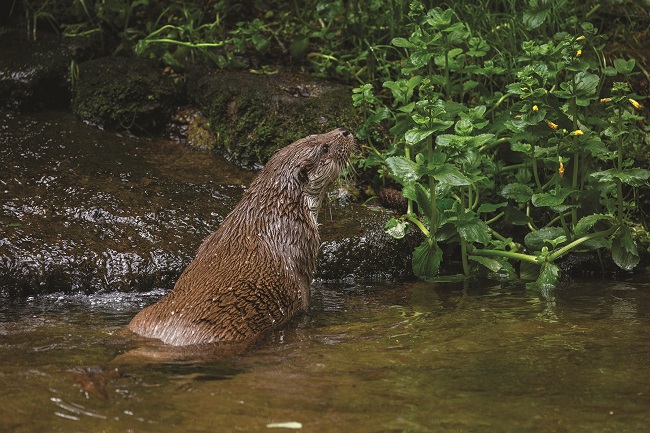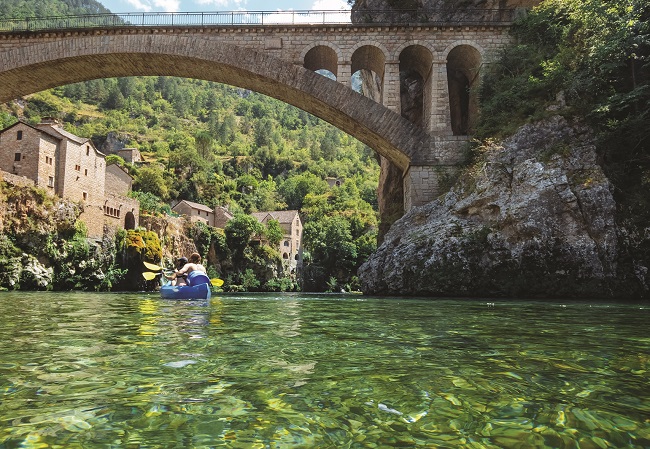The Weird Wildlife in France’s Waterways
There’s something in the water… Explore the weird and wonderful wildlife swimming in France’s waterways, some of which is down to the exotic pets of the past
Pythons in the Seine and crocodiles in the Rhône: the wildlife found in France’s rivers could give the Amazon basin a run for its money. The French have a history of keeping exotic pets, but what happens when they escape?
A killer whale is the last thing you expect to see as you flâne lazily along the banks of the Seine. A romantic break in Paris in spring as the cherry blossom starts to bloom sounds idyllic, but what if there was a testicle-ravaging fish lurking in the water below the Pont des Arts, ready to rob you or your partner of your chance to procreate? Or if your sightseeing tour aboard a bateau mouche revealed views not only of the turrets of the Palais de Justice and scaffolded spires of Notre-Dame, but of passing crocodiles too?

Salvador Dalí had a pet ocelot © NYWTS Library of Congress. New York World-Telegram & Sun Collection. Author Roger Higgins
It may sound sensationalist, but fact has a tendency to be stranger than fiction. The curiosities fished out of France’s waterways far outstrip a borrowed Vélib’ or supermarket shopping trolley (although there are plenty of those in France’s rivers too). With more than 100 rivers, four of which are over 500km in length, France has plenty of biodiverse waterways, including lakes and streams which are home to coypu, dragonflies, frogs (bien sûr), many species of fish, beavers, otters and – sometimes – rather larger creatures.
In France, the penchant for keeping exotic pets is nothing new. Long before Tiger King’s Joe Exotic flaunted his collection of big cats to a (literally) captive audience during lockdown, Salvador Dalí was taking his pet ocelot, Babou, to see exhibitions in Parisian art galleries. Josephine Bonaparte, wife of Napoleon, was the original cool cat ahead of Carole Baskin, and among her coterie of exotic pets were emus, kangaroos and an orangutan called Rose. Rose reportedly wore white dresses, learned to eat with a knife and fork, and even slept in the marital bed with Josephine and Napoleon. Charlemagne had a pet elephant, Francis I had a snow leopard that slept at the foot of his bed, and actress, journalist and suffragette Marguerite Durand kept a lion that went by the name of Tiger – the list goes on.

The market for exotic pets is booming in France
Undomesticated pets
While today’s exotic pet owners might keep their unusual animal companions better hidden than in Dalí’s day, the trade for exotic animals in France is booming, making up 20% of all animal sales. Although it must be noted that an ‘exotic’ animal is defined as anything that isn’t a dog, cat or farm animal, meaning that a goldfish has the same classification as a wolverine.
In 2009, a snapping turtle, native to North America, was discovered in the Seine, assumed to be a domestic pet. Fortunately, although snapping turtles may look and sound dangerous, they rarely attack and are actually pretty docile. Less docile, though, was an unexpected bycatch made by a Parisian fisherman in 2013. Disentangling what he first thought was a carp or a catfish from his fishing tackle, he found that it sported a double row of gleaming teeth, which, it turned out, belonged to a pacu, a South American fish from the piranha family. Pacus generally feast on nuts which have fallen into the river, but have been known to mistake their regular nut-based diet for the human kind. Fishermen have bled to death after having their testicles devoured by a short-sighted pacu. Authorities believed that this too had been a pet. As if nuts-nibbling fish and a snapping turtle weren’t enough, in 2016, Paris River Police were surprised to spot a large snake floating along the River Seine. Retrieving it from the water, they found it to be missing its head (an enemy of the Revolution perhaps?) but even so, it measured a whopping 3m and weighed 40kg. They suspected it had grown too large for its owners to cope, especially in the average shoebox-sized Parisian apartment.

Otters are returning to French waterways after almost reaching extinction © shutterstock
A monster in Paris?
One of the most famous and bizarre discoveries in France’s waterways was a crocodile named Eleanor. Eleanor was found in Paris’s sewers in 1984 when she was still very young, dining on rats. A crocodile living wild in central Paris was considered somewhat dangerous, so rather than launching a trophy hunt as in the Vanessa Paradis film, Un monstre à Paris, Eleanor was transferred to an aquarium in Vannes, Brittany, where she lived until she was transferred to a crocodile farm in Pierrelatte, Auvergne-Rhône-Alpes, where she died last year. Aquarists in Vannes even decorated Eleanor’s enclosure to resemble a Parisian sewer so she’d feel at home.
Surprisingly, if the legends of the Rhône crocodile are to be believed, this isn’t the first time a crocodile has found its way into France’s waterways. The story goes that in 1745, a crocodile was terrorising the inhabitants of Lyon. Lurking under the Guillotière Bridge in the city centre, the crocodile delighted in overturning passing boats, feasting on the unfortunates who plunged into the water. It was thought that it had escaped from a boat in Marseille. The reasons for the crocodile being on the ship in the first place are unclear, but it’s likely it was en route to become a pet for someone wealthy. From Marseille, the crocodile swam the not insignificant 300km or so upstream to take up residence in Lyon. The local authorities despaired until two local men who had been sentenced to death for their crimes saw an opportunity: they pledged to capture the crocodile if their death sentence would be revoked as a result. Seeing two criminals as a lesser threat than a giant, man-eating reptile, the authorities agreed. The men were successful and the crocodile’s skin was hung proudly in the Grand Hôtel Dieu, which today houses one of the finest hotels in Lyon, alongside boutique shops and a covered food market.
Increasingly, reports of unusual wildlife in France’s waterways come not from escaped pets, but from marine life native to the Arctic Circle getting lost or migrating due to melting ice caps. In 2021, the infamous Wally the Walrus visited France on his grand European tour, which saw him pass by Ireland, Wales, Spain and Iceland, before spending a prolonged spell on the Isles of Scilly. Wally holidayed in La Rochelle, Nouvelle-Aquitaine, and while his antics provided photo opportunities for tourists, the reality of seeing walruses and orcas so far south is much more sinister. Since 1900, sea temperatures in the Arctic have risen by over 2ºC, causing sea ice to retreat and destroying habitats.
Where climate change isn’t the cause, human interference has had a role to play. In May 2022, an orca was found dead in the Seine near Rouen, in Normandy. “There’s a wind turbine park being built in Courseulles-sur-Mer,” says Lamya Essemlali, president of NGO Sea Shepherd France. “When orcas hear loud noise anywhere within a 15km radius it can disorientate them and we think that the construction work confused this young orca and caused it to get lost. At the time of death, it hadn’t eaten for three weeks, so it must have separated from the pod around then. It’s very worrying and although this is the first time this has happened in France, orcas have been disorientated by wind turbine construction in other countries, so we need to ensure it doesn’t happen again.”

The best chance to spot France’s water wildlife is to hire a canoe or kayak © shutterstock
Endemic species returning
It’s not all doom and gloom on France’s waterways, though: two species that were on the brink of extinction have been reintroduced with great success. The Eurasian beaver had all but disappeared from the country by the 1960s after being hunted extensively for its pelt. Nationwide reintroduction projects have seen numbers rise astronomically, and now Alsace alone numbers some 400 beavers. Otters are on the rise too, slowly but surely. Hunted for their fur, there were only around 1,500 otters in the whole country by the end of the 1970s, but this figure has since doubled, with particularly significant populations on the Breton coast. An altogether more welcome sight on France’s waterways than an escaped crocodile.
Where to spot France’s aquatic life?
- Paddleboard, canoe or kayak in the Gorges du Tarn to spot beavers.
Various options available, from €23pp.
www.canoeblanc.com - Follow the tracks of otters along Brittany’s pink granite coast.
Self-guided walks, gpx files available through the website.
www.bretagne-cotedegranitrose.com - Hire a péniche (barge) to spot flamingos on the Camargue
Boat hire from Arles starts from €1,057 per week for a péniche for five people.
www.locaboat.com - Want to get involved in cleaning up France’s waterways? Lyon-based Diving for Future organises diving trips to fish waste out of the river. At Au fil de l’Orne, Caen, Normandy, borrow a kayak for free if you’re undertaking a river clean.
www.divingforfuture.fr & aufildelorne.fr
From France Today magazine
Lead photo credit : Eleanor the crocodile was found living off rats in Paris’s sewer
Share to: Facebook Twitter LinkedIn Email
More in animals, French rivers, stories, waterways in France, wildlife
Leave a reply
Your email address will not be published. Required fields are marked *






REPLY